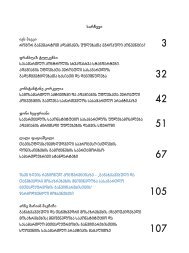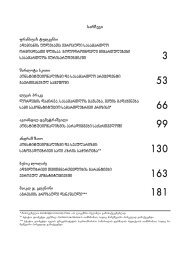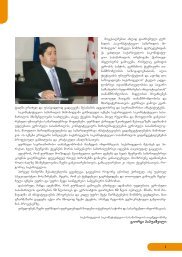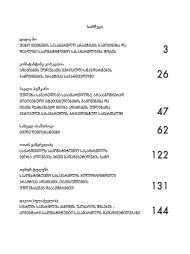Contents - Constitutional Court of Georgia
Contents - Constitutional Court of Georgia
Contents - Constitutional Court of Georgia
Create successful ePaper yourself
Turn your PDF publications into a flip-book with our unique Google optimized e-Paper software.
The European <strong>Court</strong><strong>of</strong> Human Rights is Fifty. Recent trends in the <strong>Court</strong>’s jurisprudence<br />
and in partnership with national Supreme and <strong>Constitutional</strong> <strong>Court</strong>s, serves to infuse national<br />
legal systems with the democratic values and the legal principles <strong>of</strong> the Convention<br />
and helps to ensure that Convention standards are implemented in everyday practice. The<br />
major challenge for the <strong>Court</strong> today is not only to maintain and develop the Convention<br />
standards but also to ensure that the Europe <strong>of</strong> human rights remains a single entity with<br />
common values.<br />
In response to this problem, the Committee <strong>of</strong> Ministers <strong>of</strong> the Council <strong>of</strong> Europe adopted<br />
Protocol No. 14 to the ECHR in May 2004, together with a number <strong>of</strong> recommendations<br />
and resolutions designed to increase its effectiveness. The aim <strong>of</strong> this reform is to allow the<br />
<strong>Court</strong> to devote more attention to meritorious applications, in particular those disclosing<br />
serious human rights violations, by increasing its filtering capacity and improving the implementation<br />
<strong>of</strong> the ECHR at national level. I will mention some <strong>of</strong> the most important changes<br />
encompassed by Protocol no. 14 which will enter into force on 1 June 2010.<br />
The <strong>Court</strong> will be competent to sit in a single judge formation to declare cases inadmissible<br />
or strike them out <strong>of</strong> the <strong>Court</strong>’s list <strong>of</strong> cases, where such a decision can be taken<br />
without further examination (Art. 4 and 5). In principle the decisions on admissibility and<br />
the merits will be taken at the same time (Art. 9).<br />
The competence <strong>of</strong> the Committee <strong>of</strong> three judges is enlarged. It can declare cases admissible<br />
and also render a judgment on the merits, if the underlining question in the case,<br />
concerning the interpretation or the application <strong>of</strong> the Convention or the Protocols thereto,<br />
is already the subject <strong>of</strong> well-established case-law <strong>of</strong> the <strong>Court</strong> (Art. 8).<br />
At the request <strong>of</strong> the Plenary <strong>Court</strong>, the Committee <strong>of</strong> Ministers may, by unanimous decision,<br />
and for a fixed period, reduce to five the number <strong>of</strong> judges <strong>of</strong> the Chambers (Art. 5).<br />
A new admissibility criteria is added (Art. 12), changing Article 35 § 3, in that a case is<br />
declared inadmissible if the applicant had not suffered a significant disadvantage, unless<br />
respect for human rights as defined in the Convention and the Protocols thereto requires<br />
an examination <strong>of</strong> the application on the merits and provided that no case may be rejected<br />
on this ground which has not been duly considered by a domestic tribunal.<br />
A new paragraph 4 will be added to Article 46 <strong>of</strong> the Convention (Art. 16) which allows<br />
the Committee <strong>of</strong> Ministers, if it considers that a High Contracting Party refuses to abide by<br />
a final judgment in a case to which it is a party, to refer to the <strong>Court</strong> the question whether<br />
that Party has failed to fullfill its obligation under paragraph 1, after serving formal notice<br />
on that Party and by decision adopted by a majority vote <strong>of</strong> two thirds <strong>of</strong> the representatives<br />
entitled to sit on the Committee.<br />
Furthermore, some Recommendations to the Member states were adopted by the Committee<br />
<strong>of</strong> Ministers on 12 May 2004, such as Recommendation Rec(2004) 5, to ensure that<br />
there are appropriate and effective mechanisms for systematically verifying the compatibility<br />
<strong>of</strong> draft laws with the Convention in the light <strong>of</strong> the case-law <strong>of</strong> the <strong>Court</strong>; there<br />
43






